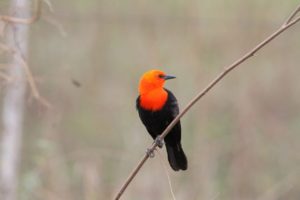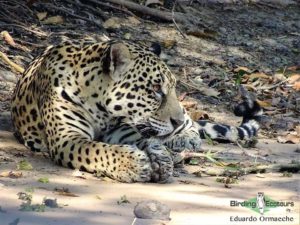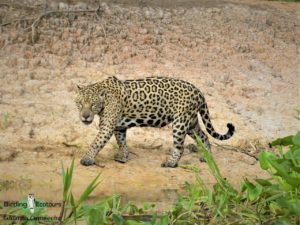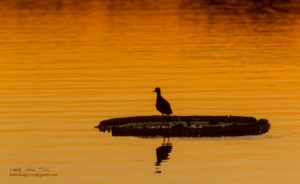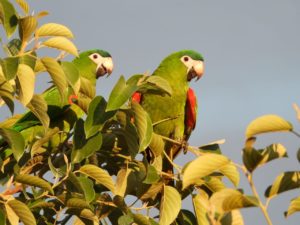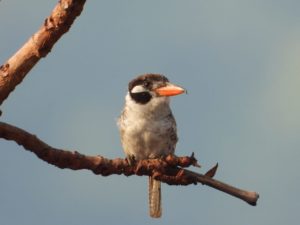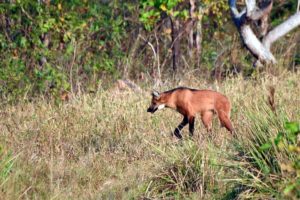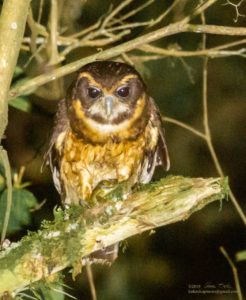Go to Cerrado, Amazon and Pantanal bird tour page | Brazil bird tours | Neotropical trip reports | All our birding tours
DOWNLOAD TRIP REPORT
05-21 OCTOBER 2019
By Eduardo Ormaeche
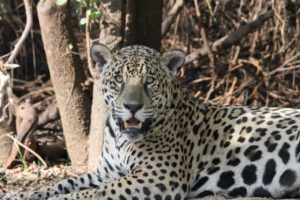
Jaguar was a major target on this tour (photo John Trathen).
Overview
Our 2019 “The Best of Brazil: Pantanal, Cerrado and Atlantic Forest” tour allowed all participants to have encounters with a great selection of birds and by far the best experience with the finest wildlife in the Neotropics. The Pantanal, a name that conjures up vast and remote wetlands full of aquatic species and one of the last refuges of the Jaguar is an obligatory destination in South America for birdwatchers and nature lovers. During our visit to the Pantanal we were rewarded with views of some sought-after species like Hyacinth Macaw, Southern Screamer, Bare-faced Curassow, Chestnut-bellied Guan, Golden-collared Macaw, Red-legged Seriema, Greater Rhea, Sunbittern, Sungrebe, Zigzag Heron, Pale-crested Woodpecker, Helmeted Manakin, Great and Common Potoos, Roseate Spoonbill, Ashy-headed Greenlet, Guira Cuckoo, Striped Cuckoo, Narrow-billed Woodcreeper, Mato Grosso Antbird, Campo Flicker, Red-crested Cardinal, and Chotoy Spinetail. In addition abundant aquatic species were found, including magnificent views of the imposing Jabiru all across the Pantanal. The Pantanal rewarded us with amazing views of four of the big five mammals of Brazil, including breathtaking sightings of four Jaguars along the Cuiaba River, Lowland Tapirs during night drives, a spectacular predawn sighting of Giant Anteater, and several encounters with Giant Otters.
The grasslands and deciduous and gallery forest habitats of the Chapada dos Guimarães National Park provided some spectacular views of species such as Blue-winged Macaw, Red-and-green Macaw, Peach-fronted Parakeet, Pheasant Cuckoo, Rufous-tailed Jacamar, Brown Jacamar, Sharp-tailed Streamcreeper, Shrike-like Tanager, Cinnamon Tanager, White-eared Puffbird, Chapada Flycatcher, Large-billed Antwren, Channel-billed Toucan, and White-vented Violetear. Perhaps one of the greatest encounters of the trip was the seldom-seen Maned Wolf as two individuals were seen just after sunset, becoming one of the highlights for many of the participants.
The Atlantic Forest, characterized by high biodiversity and endemism, provided great sightings of bird species restricted to this unique ecosystem. On this trip we focused on two major classic regions in Southeast Brazil, Ubatuba and Itatiaia National Park. The selection of species we saw was outstanding, including colorful and gorgeous species and many range-restricted and secretive birds, including Gilt-edged Tanager, Red-necked Tanager, Green-headed Tanager, Brassy-breasted Tanager, Diademed Tanager, Olive-green Tanager, Slaty Bristlefront, Orange-eyed Thornbird, Long-billed Wren, Black-capped Foliage-gleaner, Rufous Gnateater, Blackish-cheeked Gnateater, Tufted Antshrike, Ferruginous Antbird, Tawny-browed Owl, Bare-throated Bellbird, Green-billed Toucan, Saffron Toucanet, Itatiaia Spinetail, Frilled Coquette, Saw-billed Hermit, Golden-winged Cacique, Red-and-white Crake, Firewood-gatherer, and the spectacular Black-and-gold Cotinga.
We had been worried about the recent fires that sadly have affected large portions of the Brazilian Amazon and the Cerrado, but fortunately we saw only a few burned patches of cerrado and pastures in Chapada dos Guimarães National Park, and neither our trip nor the major habitats we visited had been affected by fire.
Detailed Report
Day 1, October 5th 2019. Arrival in Cuiabá, transfer to the hotel
Our group met in the city of Cuiabá, the capital of the Mato Grosso state of Brazil, where the group arrived on different flights and at different times. Those who arrived before midday enjoyed a delicious lunch at the Aeroporto Grill restaurant, where we had a pleasant introduction to the Brazilian cuisine. In town we saw our first Grey-breasted Martin, Cattle Tyrant, House Wren, and Rock Dove. Later in the evening we met the rest of the team and decided to go back to the nice restaurant to taste more of the delicious Brazilian food and the first of many rounds of caipirinhas (the Brazilian national cocktail). Not long before we ended our meal the sky opened, bringing long and heavy rain that lasted all night. What a great welcome!
Day 2, October 6th, 2019. Drive to Poconé and to the Pantanal
After an early breakfast we left Cuiabá and headed toward the Pantanal. Fortunately the rain had passed a few hours ago, producing an overcast morning with cool temperatures. It seemed as if the birds had been waiting for that rain, considering the lack of rain they had faced during the past weeks.
What a fantastic morning along the road to Poconé and through the Pantanal! We had great views of species such as Buff-necked Ibis, Bare-faced Ibis, Whistling Heron, Striated Heron, Brazilian Teal, and Black-bellied Whistling Duck. The excitement increased with our first views of Toco Toucan, Golden-collared Macaw, Red-shouldered Macaw, Sayaca Tanager, White-lined Tanager, Picazuro Pigeon, Campo Flicker, Southern Crested Caracara, Saffron Finch, Greyish Baywing, Yellow-billed Cardinal, Rufous Hornero, and Chalk-browed Mockingbird. After the joy of this first road stop we found our first Red-legged Seriema and Greater Rhea en route. After this great introduction to the birds of the Pantanal we drove to Pousada Piuval, on the way seeing more exciting species including Ringed, Green, and Amazon Kingfishers, Wood Stork, Cocoi Heron, Little Blue Heron, Plumbeous Ibis, Buff-necked Ibis, Grey-necked Wood Rail, and Chaco Chachalaca. We also saw our first Capybara group near the entrance to Pousada Piuval and found the first gathering of Yacaré caimans. We went straight to the lodge restaurant for a delicious buffet lunch, and after checking into the rooms and dropping our luggage we met outside the rooms to explore the surroundings of Pousada Piuval.
The afternoon was alive with birds around the lodge, including new ones for the day like White-rumped and White-winged Swallows, Brown-chested Martin, Grey-breasted Martin, Grey Monjita, Great Kiskadee, Crested Oropendola, White-eyed Parakeet, Black-backed Water Tyrant, White-headed Marsh Tyrant, Jabiru, and Roseate Spoonbill. We headed to the Bento Gomes River, where we were lucky enough to find a pair of Hyacinth Macaws roosting on their nest. It was amazing, almost magical, to see the largest parrot in the world and one of the most representative species of the Pantanal so well. In this area we also saw Large-billed Tern, Rufescent Tiger Heron, Chopi Blackbird, Yellow-chinned Spinetail, and our first Sunbittern, as well as a group of Azaras’s Capuchins. With spectacular views of the sunset we interrupted the birding for dinner, after which we had a night drive in search of nocturnal wildlife. We spotted several nightjars along the jeep track, including Pauraque and Little Nightjar, and luckily also had a close-up encounter with two Lowland Tapirs. What an amazing first day in the Pantanal!
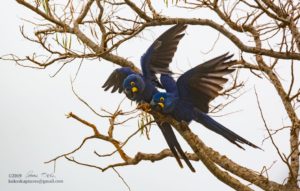
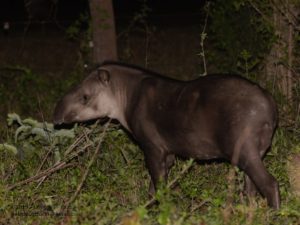
Day 3, October 7th 2019. Pousada Piuval and transfer to Pantanal Mato Grosso Hotel
We decided to have a predawn start to drive the lodge’s main road, looking for our first non-bird target of the day. And not long after sunrise there it was, the spectacular Giant Anteater, exploring the anthills not far away from us. It was just perfect!
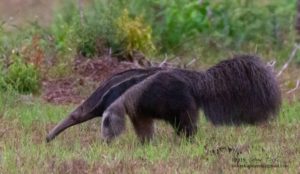
After this incredible sighting we explored some woodlands near the lodge, where we saw our first Bare-faced Curassow. In addition we found the endemic Chestnut-bellied Guan, Chaco Chachalaca, the beautiful and shy Pale-crested Woodpecker, Lineated Woodpecker, Little Woodpecker, Great Antshrike, and Fork-tailed Flycatcher (of which we probably had a hundred records during the whole tour). During the remainder of the morning we added more species such as Short-crested Flycatcher, Masked Tityra, Fawn-breasted Wren, Thrush-like Wren, more Toco Toucans, Ferruginous Pygmy Owl, Southern Beardless Tyrannulet, Masked Gnatcatcher, Black-collared Hawk, Gilded Sapphire, Glittering-throated Emerald, Limpkin, and our first group of South American Coatis.
After lunch we transferred to the Pantanal Mato Grosso Hotel and spent the afternoon exploring the Pixaim River in search of more species. We managed to find Blue-throated Piping Guan, Anhinga, Cocoi Heron, Neotropic Cormorant, American Pygmy Kingfisher, Ringed, Green, and Amazon Kingfishers, Solitary Cacique, Band-tailed Antbird, Sungrebe, Black-collared Hawk, and Rufescent Tiger Heron. We also had our first encounter with a family of Giant Otters, which was an amazing moment for the entire group but especially for Mark and Maria, who were hoping very much to see this animal, which sadly they had missed on our Southern Peru tour in 2016. We had good views of the otters. Then we looked for our target of the day, the crepuscular and shy Zigzag Heron. We tried hard to find the bird, but on this afternoon it was heard only. We did not give up, though, and we made an alternative plan for the next day. While having dinner we had two visitors at the lodge, namely another Lowland Tapir and a Crab-eating Raccoon.
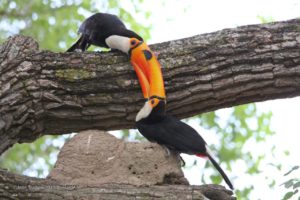
Day 4, October 8th 2019. Pantanal Mato Grosso Hotel grounds
We had another predawn start for a twilight boat ride along the Pixaim River to try again for the Zigzag Heron. We sailed directly to the spot where we had heard it on the previous evening. Luckily this time, after some patience, we had incredible success not with one but with a pair of Zigzag Herons not far from us. We also saw several Band-tailed Nighthawks flying by and a Boat-billed Heron. What an amazing start!
We came back to the lodge, and after a tasty breakfast we got ready to hit the wonderfully birdy surroundings of the hotel. We started with the gallery forest, where we saw our first Mato Grosso Antbird, Rusty-backed Spinetail, White-lored Spinetail, Barred Antshrike, Rufous-tailed Jacamar, Yellow-olive Flatbill, Helmeted Manakin, Buff-throated Woodcreeper, Pale-crested Woodpecker, Black-fronted Nunbird, White-tipped Dove, Stripe-necked Tody-Tyrant, Fawn-breasted Wren, and Band-tailed Antbird. After the gallery forest we moved to the open habitat along the airstrip, where we added Picui Ground Dove, Long-tailed Ground Dove, Red-crested Cardinal, Yellow-billed Cardinal, Purplish Jay, Shiny Cowbird, Giant Cowbird, Guira Cuckoo, Greyish Saltator, Greater Thornbird, White-bellied Seedeater, Chestnut-bellied Seed Finch, Masked Gnatcatcher, Orange-backed Troupial, Red-throated Piping Guan, and Blue-throated Piping Guan to our list. We also had great views of Chotoy Spinetail, Campo Flicker, Unicolored Blackbird, White-headed Marsh Tyrant, Scarlet-headed Blackbird, Striped Cuckoo, White-eyed Parakeet, Monk Parakeet, Orange-winged Amazon, and Buff-bellied Hermit. It also was a good day for mammals, with new species including a family of Marsh Deer and Yellow Armadillo. In the evening we tried for Spot-tailed Nightjar, which was heard only.
Scarlet-headed Blackbird (photo John Trathen)
Day 5, October 9th 2019. Drive along the Transpantaneira to Porto Jofre
After an early breakfast we left the Pantanal Hotel Mato Grosso and drove along the Transpantaneira toward Porto Jofre. On the way we saw many species, such as lots of Jabirus, Wood Stork, Limpkin, Cocoi Heron, Black-collared Hawk, Grey-necked Wood Rail, Chaco Chachalaca, White-headed Marsh Tyrant, and Rusty-collared Seedeater. We also had splendid views of White Woodpecker on the way. Near Porto Jofre we found Great Horned Owl roosting at daytime at its usual place and enjoyed good views of Cinereous-breasted Spinetail, Pearly-vented Tody-Tyrant, Ashy-headed Greenlet, and Straight-billed Woodcreeper.
Once we had arrived at the Hotel Pantanal Norte – Porto Jofre we had enough time to check into the rooms, drop the luggage, and enjoy another tasty lunch before we started our first Jaguar boat safari along the Cuiabá River, where we had nice views of Collared Plover, Black Skimmer, Black-bellied Whistling Duck, and Large-billed, Yellow-billed, and Common Terns.
The main target for the afternoon was finding the Jaguar, the largest felid in the Americas and the third-largest in the world after Tiger and Lion. One has to be extremely lucky to spot one in the Central American rainforest or in the Manu and Tambopata National Reserves in Peru, but the Pantanal offers great chances not only for sightings but also for photography and to observe the behavior of this magnificent creature. We took our boat along the Cuiabá River, and after we had turned into one of its tributaries, the Three Brothers River, suddenly our boat driver increased the speed and took us straight to a Jaguar that had been found by another boat. These sightings are very exciting, even if you have had them several times; it always feels like you are finally achieving that (perhaps long-awaited) Neotropical dream. Our most impressive encounter was with a beautiful individual chasing along the riverbank and trying to hunt possibly a caiman or an anaconda hiding under the aquatic vegetation. Watching this hunting behavior was very special for all participants.
Jaguar along the Cuiabá River
Jaguar along the Cuiabá River
After having greatly enjoyed the Jaguar we found another family of Giant Otters. This sighting was amazing, as we saw the whole family crossing the river and a large female with its offspring in her mouth, everything accompanied by the otters’ noisy contact calls. The best present for Mark’s birthday!
Giant Otters (photo John Trathen)
We headed back to Porto Jofre, enjoying the sunset and more Band-tailed Nighthawks rising in the sky above the Cuiabá River.
A spectacular view in the Pantanal
Day 6, October 10th 2019. Cuiabá River and the vicinity of Porto Jofre
We had another Jaguar excursion on schedule for the morning. It is better to maximize the chances in case we would unluckily have missed the Jaguar on the previous day or the sighting would not have been good enough for the group. Therefore with the pressure out of the way we started our boat trip along the Cuiabá River and actually encountered other Jaguars; however, the sighting and the boat traffic around it did not beat our first encounter. We also managed to find more Giant Otters and Black-and-gold Howler Monkeys as well as more of the typical common river birds than we had ever seen.
After arrival back at the lodge we spent some time watching some waders near the lodge, including Greater and Lesser Yellowlegs, White-rumped Sandpiper, Pectoral Sandpiper, and Solitary Sandpiper.
The afternoon was hot, and we drove along the Transpantaneira from the Hotel Pantanal Norte – Porto Jofre, but we only added more of the species we had already seen, although a few of us managed to get a glimpse of the secretive Grey-breasted Crake.
Day 7, October 11th 2019. Porto Jofre to Pouso Alegre Lodge
After breakfast we left the Hotel Pantanal Norte – Porto Jofre and drove back along the Transpantaneira, making a stop at an abandoned research facility where we had always been lucky with a number of interesting species. Not long after we parked we had great views of Scaly-headed Parrot, Chestnut-eared Aracari, Blue-throated Piping Guan, Squirrel Cuckoo, Bat Falcon, Striped Cuckoo, White-winged Becard, Hyacinth Macaw, Crested Oropendola, and Grey-headed Tanager. We then headed to Pousada Rio Claro, where we had lunch and nice views of Nanday Parakeet at the lodge feeders. Continuing toward our accommodation we saw Southern Crested Caracara, Yellow-headed Caracara, Chestnut-bellied Guan, Chaco Chachalaca, Greyish Baywing, Yellow-billed Cardinal, and Lineated Woodpecker. Sadly only a few of us got a glimpse of Crane Hawk. However, Savanna Hawk and Roadside Hawk were seen well several times during our stay in the Pantanal.
The afternoon proved to be quiet and hot at Pouso Alegre Lodge, so we stayed around the lodge and saw Purplish Jay, Creamy-bellied Thrush, Whistling Heron, Capped Heron, Sunbittern, Grey-necked Wood Rail, and others. After dinner we made a night drive around the great deciduous woodlands of Pouso Alegre and managed to see Crab-eating Fox, Tapeti (Brazilian Rabbit), and another Lowland Tapir. The night birding was quiet, but we added Boat-billed Heron and a few Pauraques.
Day 8, October 12th 2019. Pouso Alegre to Chapada dos Guimarães
We spent the morning birding the woodlands of Pouso Alegre, where we found Grey-crested Cacholote, Thrush-like Wren, Southern Yellowthroat, Chopi Blackbird, Pale-crested Woodpecker, Hyacinth Macaw, and Monk Parakeet, but unfortunately we could not find Great Rufous Woodcreeper. Here the group also enjoyed views of Black-tailed Marmoset and Azaras’s Capuchin. After lunch we packed all our gear and continued our tour, leaving the Pantanal behind but with the promise of further adventures during the rest of the trip – what an incredible place! We arrived at the Chapada dos Guimarães late in the afternoon and were ready for a checklist session and a good dinner.
Day 9, October 13th 2019. Chapada dos Guimarães
An early start allowed us to explore some of the dusty tracks adjacent to the Chapada dos Guimarães National Park. This area is particularly good and relatively accessible for some Cerrado special birds that are not found in the Pantanal and are more range-restricted. We started our day with incredible views of Cinnamon Tanager, Chapada Flycatcher, White-banded Tanager, White-rumped Tanager, and White-eared Puffbird.
Later we moved to the forested area called Vale da Benção and were lucky to find great species, such as the elusive Pheasant Cuckoo, which flew twice above our heads, providing great views. Other birds included Channel-billed Toucan, Red-shouldered Macaw, Saffron-billed Sparrow, Southern Antpipit, Yellow-tufted Woodpecker, Plain Antvireo, Golden-crowned Warbler, Swallow-tailed Hummingbird, Brown Jacamar, Rufous-browed Peppershrike, and the elusive Sharp-tailed Streamcreeper.
In the afternoon we drove to the Bridal Veil stakeout, where we had an impressive view of the Bridal Veil waterfall and found a few birds species, namely Cliff Flycatcher, Red-and-green Macaw, Swallow Tanager, Blue-and-white Swallow, and White-eyed Parakeet.
Red-shouldered Macaw (photo Mark Jones)
We decided to leave the park and went to a known stakeout point for Blue-winged Macaw, where breathtaking views of the cliffs and landscape of the Chapada dos Guimarães are incredible, and just before sunset and after a short, mild shower we achieved fantastic views of our target, the beautiful Blue-winged Macaw. It could not have been better! We then returned to the hotel for another checklist session, a round of caipirinhas, and of course dinner.
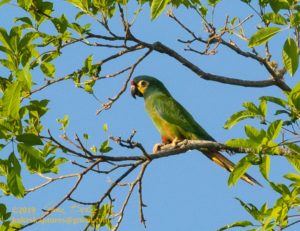
Day 10, October 14th 2019. Agua Fria Road, Chapada dos Guimarães
Today we had another early start to further explore the threatened Cerrado habitat. We arrived at the Agua Fria Road and soon heard the calls of Red-winged Tinamou and Tataupa Tinamou, but both where somewhat distant. We saw some great birds of the Cerrado again, such as Cinnamon Tanager, White-banded Tanager, White-rumped Tanager, Black-faced Tanager, Curl-crested Jay, Suiriri Flycatcher, Barred Antshrike, Plain-crested Elaenia, Burrowing Owl, Purple-throated Euphonia, and Rusty-backed Antwren. We had great views of the male antwren, but unfortunately the female was chased off before we could watch it though the scope. Our main target here was the shy Collared Crescentchest, which had been quite reliable in this area. But the crescentchest was denied us, and this was the first time on multiple tours to the area that we failed to see this species. The heat was brutal, and so we decided to go back to the hotel. Our plan for the afternoon was to explore some Cerrado habitat near the entrance of the Stone City in the national park. We had some short rain but still enjoyed good views of Peach-fronted Parakeet, Blue-and-yellow Macaw, Swallow-tailed Hummingbird, White-vented Violetear, and White-eared Puffbird.
White-eared Puffbird (photo Mark Jones)
We went to the vehicle and started our drive back to town. We were enjoying the beautiful sunset when suddenly I shouted “Maned Wolf”, and there it was next to the road, walking into the grasslands to the left of our vehicle. Fortunately the entire group managed to see it, albeit some better than others. We could not stop our joy and amazement when I spotted a second individual on the right side of the road, which started first to walk and then to run across the grasslands, and we could see the whole run; it was just fantastic. Another great moment in Brazil that would not be forgotten!
Maned Wolf (photo Ricardo Botticelli)
Day 11, October 15th 2019. Geladeira Road and transfer back to Cuiabá
Our last morning in the Chapada dos Guimarães took us to the Geladeira Road to explore the last patches of thorny cerrado. New birds of the morning were Red Pileated Finch, Grey Pileated Finch, Purple-throated Euphonia, Guira Tanager, Southern Scrub Flycatcher, Lesser and Yellow-bellied Elaenias, Sayaca Tanager, Burnished-buff Tanager, Plain-crested Elaenia, Lesser Yellow-headed Vulture, Plumbeous Kite, Tropical Parula, Fork-tailed Flycatcher, Chalk-browed Mockingbird, White-lined Tanager, Pale-breasted Thrush, and Black-throated Saltator. It was sad to watch a few patches of cerrado all burned up, but even more upsetting was finding a couple of matchboxes at one side of the road. We decided to make one more stop at the stakeout of the geodesic center of South America, which is located in the national park. We walked near the edge of a cliff, from where we had a great view. There was an unexpected King Vulture and several White-collared Swifts, and before we left we saw the obligatory Crested Black Tyrant.
After 11 days birding in the Pantanal and the Cerrado we closed this incredible chapter and were excited and keen to start a new one, the Atlantic Forest leg. We drove back to Cuiabá and unilaterally the group decided to go back to the Aeroporto Grill restaurant for a lovely dinner and two more rounds of Caipirinhas.
Day 12, October 16th 2019. Flight to São Paulo and drive to Ubatuba
We had a ludicrously early predawn start to get a 5.00 a.m. flight to São Paulo. You could feel the excitement and joy of anticipation in the air, but it was sad to say goodbye to some participants and good friends who did not join us for the Atlantic Forest part of the tour. We arrived in São Paulo and were met by our local crew, which got us ready for the long drive to Ubatuba. We felt that the drive was probably longer than it actually was, but it was long indeed. However, considering our early sleep deprivation, who could blame us?
At our lunch stop we found the first new bird, Chestnut-capped Blackbird, together with a few Saffron Finches of different ages. Continuing our transfer we drove along the shoreline, where we had glimpses of Brown Booby and Kelp Gull. We then visited a hummingbird garden in the afternoon, where we had our first frenzy encounter with feathered jewels like Black Jacobin, Saw-billed Hermit, Sombre Hummingbird, Western Emerald, Black-throated Mango, Violet-capped Woodnymph, and Festive Coquette. We arrived at our lodge in Ubatuba, ready to check in and go for dinner, checklist, and wine.
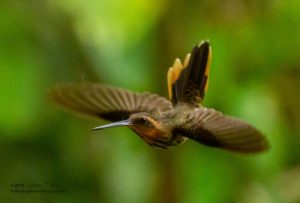
Day 13, October 17th 2019. Banana Bamboo Ecolodge
After an early breakfast we spent the day birding around the grounds of our lodge and its surroundings, finding a great set of range-restricted Atlantic Forest birds including Brazilian Tanager, Red-necked Tanager, Green-headed Tanager, Black-cheeked Gnateater, Long-billed Wren, Black-capped Foliage-gleaner, Orange-eyed Thornbird, Unicolored Antwren, Riverbank Warbler, Plain Parakeet, Maroon-bellied Parakeet, Yellow-throated Woodpecker, Olivaceous Woodcreeper, Plain-winged Woodcreeper, Ferruginous Antbird, and Rufous-capped Antthrush. In addition we saw Sao Paulo Tyrannulet, Scaly-headed Parrot, Azure-shouldered Tanager, Rufous-winged Antwren, Ruby-crowned Tanager, and Chestnut-bellied Euphonia among many other spectacular birds.
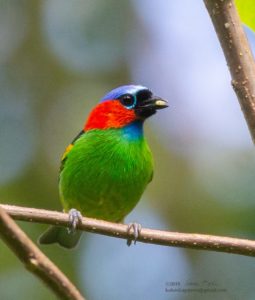
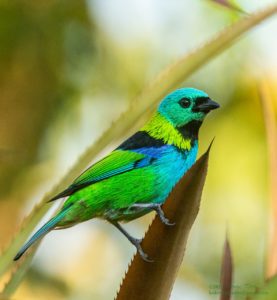
In the evening we had a wonderful encounter with an impressive Tawny-browed Owl having its dinner as it flew up to a tree from the boardwalk. Thanks to Anne’s photo we noted that its tasty prey was a decent-sized frog.
Tawny-browed Owl
Day 14, October 18th 2019. Birding Ubatuba and transfer to Itatiaia National Park
We had another predawn start, and before our breakfast was ready we had some time to watch the stars. I have not seen such a perfect, clean sky full of stars for quite some time! Suddenly we heard the call of Short-tailed Nighthawk, and then Dennis proofed his talent to imitate birds and managed to call the bird right above our heads. We also had a glimpse of a male Scissor-tailed Nightjar and Common Potoo.
After breakfast we left the lodge and climbed up the road above Ubatuba in search of more Atlantic Forest species. We started finding some interesting birds such as Fawn-breasted Tanager, Buff-browed Foliage-gleaner, White-rimmed Warbler, Golden-winged Cacique, Slaty-breasted Wood Rail, and a female Pin-tailed Manakin. Later we were treated with fantastic views of a pair of Diademed Tanagers and scope views of Bare-throated Bellbird. We also tried for the secretive Red-and-white Crake and enjoying unreal views of this secretive species.
We continued birding the road until we reached some open habitat, which was good for Band-tailed Hornero, Sooty Tyrannulet, Yellow-browed Tyrant, Firewood-gatherer, Rufous-headed Tanager, Yellow-lored Tody-Flycatcher, Hangnest Tody-Tyrant, Grey-hooded Flycatcher, and Planalto Tyrannulet.
After we arrived at Itatiaia National Park we immediately drove to the Hotel do Ypê, which was to be our base for the next three nights. We had lunch and afterwards a short break before birding around the lodge veranda and feeders, waiting for the star of the place, the gorgeous Frilled Coquette. Near the parking lot we had views of Slaty-breasted Wood Rail and Masked Water Tyrant. The feeders attracted Green-headed Tanager, the stunning Gilt-edged Tanager, Brassy-breasted Tanager, White-throated Hummingbird, Brazilian Ruby, Scale-throated Hermit, Black Jacobin, and finally the impressive Frilled Coquette.
Day 15, October 19th 2019. Itatiaia National Park (lower parts)
We spent the morning birding the surroundings areas of our hotel in the lower parts of Itatiaia National Park, hoping for Swallow-tailed Cotinga, but without success. But the morning produced Surucua Trogon, Rufous-capped Motmot, Green-billed Toucan, White-barred Piculet, Yellow-fronted Woodpecker, Maroon-bellied Parakeet, Rufous-capped Spinetail, Pallid Spinetail, Scaled Woodcreeper, Streaked Xenops, Grey-capped Tyrannulet, Planalto Tyrannulet, Ochre-bellied Flycatcher, Eared Pygmy Tyrant, Blue Manakin, Black-tailed Myiobius, Chestnut-crowned Becard, Chivi Vireo, Rufous-crowned Greenlet, Black-goggled Tanager, Red-rumped Cacique, and many others. In the afternoon we photographed birds from the veranda, including Frilled Coquette, Blue-winged Macaw, Saffron Toucanet, Long-tailed Tyrant, Sick’s Swift, White-collared Swift, and a few Biscutate Swifts.
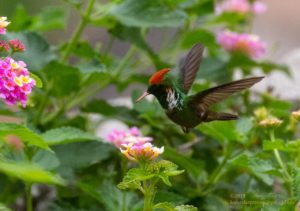
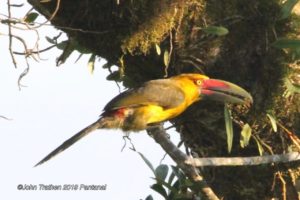
Day 16, October 20th 2019. Itatiaia National Park (upper parts)
Today we drove to the upper parts of Itatiaia National Park with great scenery of pastures surrounded by cliffs and boulders. Near a section of Pico das Agulhas Negras, Brazil’s fifth-highest mountain, we scored with our targets, the endemic Itatiaia Spinetail, Greenish Tyrannulet, Araucaria Tit-Spinetail, Pampa Finch, Black-chested Buzzard-Eagle, White-tailed Hawk, and the impressive Black-and-gold Cotinga.
In the afternoon we explored areas around our lodge, where we found some great species like Slaty Bristlefront, Rufous Gnateater, White-shouldered Fire-eye, Tufted Antshrike, Fork-tailed Pygmy Tyrant, and Serra do Mar Tyrannulet among many others.
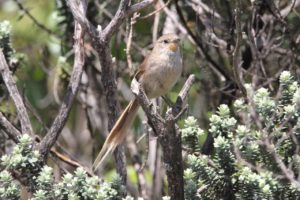
Day 17, October 21st 2019. Hotel do Ypê and transfer to São Paulo
After our last breakfast together and packing all our gear we had time to do a little birding around the lodge, finding another Slaty Bristlefront, Rufous Gnateater, Rufous-capped Motmot, the endemic White-collared Foliage-gleaner, and an unexpected Long-tailed Potoo roosting at daytime.
After 17 days of great birding in this fascinating country we then headed back to the São Paulo airport, where we said goodbye to an amazing group of people after another successful Birding Ecotours Brazil tour.
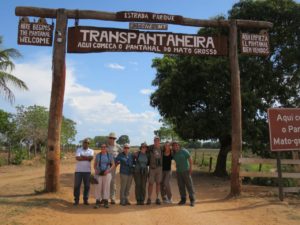
BIRD LIST (Taxonomy IOC 9.2)
Rheidae
Greater Rhea Rhea americana Seen in the Pantanal around Pousada Piuval. The Greater Rhea is the largest bird in South America. The species is classified as Near-threatened. The Portuguese name for the Rhea is Ema, giving the name to the Emas National Park in the states of Goiás in Brazil.
Tinamidae
Undulated Tinamou (H) Crypturellus undulatus Heard only in the Pantanal. One of the most distinctive bird calls in the Neotropics. Tinamous are among the oldest bird families and very shy and secretive. They have reversed sex roles. A male tinamou maintains a territory and a nesting site during the breeding season, which a succession of females will visit, laying their eggs in the same nest. Females will wander through several male territories, mating with and laying eggs in the nests of the resident males. Nests are always on the ground, concealed in vegetation or among rocks. The eggs are relatively large and glossy, often brightly colored, varying from porcelain-like turquoise to vinaceous.
Solitary Tinamou (H) Tinamus solitarius Heard only in the Atlantic Forest. The species is classified as Near threatened.
Tataupa Tinamou (H) Crypturellus tataupa Heard only at Chapada dos Guimarães. The Guaraní (Paraguayan) Indian name is ynambu tataupa, “house tinamou”, for the Tataupa Tinamou, because it occurs near villages and country haciendas.
Red-winged Tinamou (H) Rhynchotus rufescens Heard distantly at Chapada dos Guimarães
Cracidae
Chaco Chachalaca Ortalis canicollis Common in the Pantanal
Chestnut-bellied Guan Penelope ochrogaster Great views in the Pantanal. This is a Brazilian endemic. The species is classified as Vulnerable.
Blue-throated Piping Guan Pipile cumanensis Common in the Pantanal
Red-throated Piping Guan Pipile cujubi Unexpected in the Pantanal. Two birds were photographed at Pousada Piuval. Normally seen in the Amazon lowlands. A near-endemic found in Brazil and adjacent Bolivia
Bare-faced Curassow Crax fasciolata Nice views in the Pantanal. Probably the easiest curassow to see. We had great views of males and females.
Odontophoridae
Spot-winged Wood Quail (H) Odontophorus capueira This species was heard distantly in the Itatiaia National Park.
Anhimidae
Southern Screamer Chauna torquata Great views in the Pantanal
Anatidae
Black-bellied Whistling Duck Dendrocygna autumnalis Seen well on the way to Poconé
Muscovy Duck Cairina moschata Several sightings in the Pantanal
Brazilian Teal Amazonetta brasiliensis Seen during our drive to Poconé
Nyctibiidae
Great Potoo Nyctibius grandis Great sightings at daytime and at night in the Pantanal
Common Potoo Nyctibius griseus Seen in the Pantanal
Long-tailed Potoo Nyctibius aethereus An amazing sighting not far from Hotel do Ypê in the Itatiaia National Park
Caprimulgidae
Short-tailed Nighthawk Lurocalis semitorquatus Great views of one bird just after dusk at Banana Bamboo Ecolodge. Dennis, using his amazing birdcall imitation, managed to bring one bird flying directly above us.
Band-tailed Nighthawk Nyctiprogne leucopyga Seen on the boat ride on the Pixaim River in the Pantanal
Pauraque Nyctidromus albicollis Seen in the Pantanal and at Ubatuba
Little Nightjar Setopagis parvula Seen in the Pantanal. One of the most common birds during the night drives
Spot-tailed Nightjar Hydropsalis maculicaudus Brief views in the Pantanal. Mostly heard
Scissor-tailed Nightjar Hydropsalis torquata Nice views of one male before dawn at Banana Bamboo Ecolodge
Apodidae
White-collared Swift Streptoprocne zonaris Seen in the Atlantic Forest
Biscutate Swift Streptoprocne biscutata A couple of birds were seen well from the Hotel do Ypê stakeout.
Sick’s Swift Chaetura meridionalis Seen in the Atlantic Forest. Named after Helmut Sick (1910-1991), German ornithologist resident in Brazil, collector, and author (Ornitologia brasileira, uma introdução 1984)
Trochilidae
Saw-billed Hermit Ramphodon naevius Great views at the hummingbird garden near Ubatuba. A Brazilian endemic. The species is classified as Near-threatened.
Reddish Hermit Phaethornis ruber Seen at Ubatuba
Scale-throated Hermit Phaethornis eurynome Seen above Ubatuba
Buff-bellied Hermit Phaethornis subochraceus Seen briefly in the Pantanal
Sombre Hummingbird Aphantochroa cirrochloris Great views in the hummingbird garden near Ubatuba
Swallow-tailed Hummingbird Eupetomena macroura We saw our first male at the Vale da Benção in Chapada dos Guimarães National Park.
Black Jacobin Florisuga fusca Great views at the Hotel do Ypê feeders and Ubatuba. An Atlantic Forest hummingbird
White-vented Violetear Colibri serrirostris Seen in the Pantanal and Chapada dos Guimarães
Black-throated Mango Anthracothorax nigricollis Seen in Ubatuba
Green-crowned Plovercrest Stephanoxis lalandi Great views in the Itatiaia area. A Brazilian endemic. Change English name of Plovercrest to Green-crowned Plovercrest with split of Purple-crowned Plovercrest (S. loddigesii). English names provisional.
Frilled Coquette Lophornis magnificus Fantastic views of males and females at Hotel do Ypê in Itatiaia National Park. A Brazilian endemic
Festive Coquette Lophornis chalybeus Seen in the hummingbird garden near Ubatuba
Glittering-throated Emerald Amazilia fimbriata Common in the Pantanal and Chapada dos Guimarães
Gilded Sapphire Hylocharis chrysura A few seen in the Pantanal
Fork-tailed Woodnymph Thalurania furcata Seen in the Pantanal
Violet-capped Woodnymph Thalurania glaucopis Several sightings in the Atlantic Forest
White-chinned Sapphire Hylocharis cyanus Seen in the hummingbird garden near Ubatuba
Versicolored Emerald Amazilia versicolor Seen in the hummingbird garden near Ubatuba
White-throated Hummingbird Leucochloris albicollis Seen at the feeders of Hotel do Ypê at Itatiaia
Sapphire-spangled Emerald Amazilia lactea One seen in the Atlantic Forest
Brazilian Ruby Clytolaema rubricauda Great views in the hummingbird garden near Ubatuba. A Brazilian endemic
Amethyst Woodstar Calliphlox amethystina Seen in the Atlantic Forest
Cuculidae
Guira Cuckoo Guira guira Common in Chapada dos Guimarães
Greater Ani Crotophaga major Seen in the Pantanal
Smooth-billed Ani Crotophaga ani Common throughout the trip
Striped Cuckoo Tapera naevia Great scope views in the Pantanal
Pheasant Cuckoo Dromococcyx phasianellus Great views in flight at Vale da Benção in Chapada dos Guimarães
Squirrel Cuckoo Piaya cayana A few sightings
Columbidae
Rock Dove Columba livia Common in towns and cities
Picazuro Pigeon Patagioenas picazuro Common in the Pantanal and Chapada dos Guimarães. The name comes from the Guaraní (Paraguayan) Indian name Picazurú, “sour pigeon”, for the taste of its flesh after it has eaten certain fruits.
Plumbeous Pigeon Patagioenas plumbea Seen in Itatiaia National Park
Scaled Dove Columbina squammata This nice-looking dove was seen very well at different locations in the Pantanal.
Ruddy Ground Dove Columbina talpacoti Seen along pastures and open areas on the east coast
Picui Ground Dove Columbina picui Seen well in the Pantanal, where it is common. The Guaraní (Paraguayan) Indian name picui is for a small dove.
Long-tailed Ground Dove Uropelia campestris Sandra spotted one individual behind the Pantanal Mato Grosso Hotel grounds in the Pantanal. A near-endemic found in Brazil and Bolivia
White-tipped Dove Leptotila verreauxi Seen in the Pantanal and the Atlantic Forest
Heliornithidae
Sungrebe Heliornis fulica Seen well on the Pixaim River near the Pantanal Hotel Mato Grosso. Sungrebe together with African Finfoot and Masked Finfoot are the only three members of the Heliornithidae family. Sungrebes are unique among birds in that males have “pouches”, folds of skin under their wings, in which they carry their young from hatching until the chicks are able to swim for themselves. This has led to them being called “marsupial birds”.
Rallidae
Grey-breasted Crake Laterallus exilis Just a glimpse at Porto Jofre
Red-and-white Crake Laterallus leucopyrrhus Amazing views of one individual in the Atlantic Forest
Grey-necked Wood Rail Aramides cajaneus Abundant in the Pantanal
Slaty-breasted Wood Rail Aramides saracura Seen near the parking lot at Hotel do Ypê in Itatiaia National Park
Aramidae
Limpkin Aramus guarauna Abundant in the Pantanal
Recurvirostridae
White-backed Stilt Himantopus melanurus Seen in the Porto Jofre Hotel marsh. Himantopus melanurus is split from H. mexicanus (Sibley & Monroe 1990, Ridgely & Greenfield 2001); SACC awaits more study.
Charadriidae
Southern Lapwing Vanellus chilensis Common throughout the trip
Collared Plover Charadrius collaris Seen along the sand banks of the Cuiabá River
Pied Plover Hoploxypterus cayanus Seen along the river banks of the Cuiabá River
Jacanidae
Wattled Jacana Jacana jacana Abundant in the Pantanal
Scolopacidae
White-rumped Sandpiper Calidris fuscicollis Seen in the Porto Jofre Hotel marsh
Pectoral Sandpiper Calidris melanotos Seen in the Porto Jofre Hotel marsh
Solitary Sandpiper Tringa solitaria Seen in the Porto Jofre Hotel marsh
Lesser Yellowlegs Tringa flavipes Seen in the Porto Jofre Hotel marsh
Greater Yellowlegs Tringa melanoleuca Seen in the Porto Jofre Hotel marsh
Laridae
Black Skimmer Rynchops niger Seen along the sandbars of the Cuiabá River
Kelp Gull Larus dominicanus Seen along the Atlantic coast during our drive to Ubatuba
Common Tern Sterna hirundo One individual was seen on the Cuiabá River. This is a vagrant species in the Pantanal.
Large-billed Tern Phaetusa simplex Seen in the Pantanal, where it is relatively common
Yellow-billed Tern Sternula superciliaris A few sightings along the Cuiabá River
Eurypygidae
Sunbittern Eurypyga helias Great views at Pousada Piuval. A monotypic member of the family Eurypygidae. It is found in Central and South America and has three subspecies. The Sunbittern shows both morphological and molecular similarities with the Kagu (Rhynochetos jubatus) of New Caledonia, indicating a gondwanic origin, both species being placed in the clade Eurypygiformes.
Ciconiidae
Wood Stork Mycteria americana Common in the Pantanal
Jabiru Jabiru mycteria Great views in the Pantanal, including birds with chicks on nests. The name comes from a Tupi–Guaraní language and means “swollen neck”.
Sulidae
Brown Booby Sula leucogaster A couple of birds were seen along the Atlantic coast during the long drive to Ubatuba.
Phalacrocoracidae
Neotropic Cormorant Phalacrocorax brasilianus Common in the Pantanal
Anhingidae
Anhinga Anhinga anhinga Seen in the Pantanal. The Tupí (Brazilian) Indian name anhingá or anhangá is for the devil bird, an evil spirit of the woods. The name was first used as an English name in 1818 for the Afrotropical darter.
Threskiornithidae
Plumbeous Ibis Theristicus caerulescens Close-up views in the Pantanal. One of the handsomest Neotropical ibises
Buff-necked Ibis Theristicus caudatus Nice views in the Pantanal
Green Ibis Mesembrinibis cayennensis A couple of encounters on the trip
Bare-faced Ibis Phimosus infuscatus Seen in the Pantanal
Roseate Spoonbill Platalea ajaja Great views in the Pantanal. One of Sue’s favorite species
Ardeidae
Rufescent Tiger Heron Tigrisoma lineatum Common in the Pantanal
Boat-billed Heron Cochlearius cochlearius Seen in the Pantanal during the night boat ride and one at Pouso Alegre during the night walk
Zigzag Heron Zebrilus undulatus An amazing sighting of two individuals on the Pixaim River just after dawn, magical. This is one of the hardest-to-see Neotropical herons. The species is classified as Near-threatened.
Whistling Heron Syrigma sibilatrix Seen during our drive to Poconé and in the Pantanal
Striated Heron Butorides striata Common in the Pantanal
Western Cattle Egret Bubulcus ibis Several sightings along the Atlantic coast on the way to Ubatuba
Cocoi Heron Ardea cocoi Common in the Pantanal
Great Egret Ardea alba Common in the Pantanal
Capped Heron Pilherodius pileatus Seen in the Pantanal
Little Blue Heron Egretta caerulea Seen in the Pantanal
Snowy Egret Egretta thula Several sightings in the Pantanal
Cathartidae
Turkey Vulture Cathartes aura Common throughout the trip
Lesser Yellow-headed Vulture Cathartes burrovianus Seen well in the Chapada dos Guimarães
Black Vulture Coragyps atratus Common throughout the trip
King Vulture Sarcoramphus papa Seen well at the geodesic center stakeout in the Chapada dos Guimarães National Park
Pandionidae
Western Osprey Pandion haliaetus Seen in the Pantanal
Accipitridae
Swallow-tailed Kite Elanoides forficatus Seen in Ubatuba and Itatiaia National Park in the Atlantic Forest
Grey-headed Kite Leptodon cayanensis Brief views of one individual in Ubatuba
Rufous-thighed Kite Harpagus diodon Nice views of one individual on our last morning at Itatiaia National Park
Plumbeous Kite Ictinia plumbea Several sightings at Chapada dos Guimarães
Black-collared Hawk Busarellus nigricollis Common in the Pantanal
Snail Kite Rostrhamus sociabilis Abundant in the Pantanal
Crane Hawk Geranospiza caerulescens Brief views of one individual in the Pantanal
Savanna Hawk Buteogallus meridionalis Seen in the Pantanal and Chapada dos Guimarães
Great Black Hawk Buteogallus urubitinga Seen in the Pantanal
Roadside Hawk Rupornis magnirostris Several sightings throughout the trip
Black-chested Buzzard-Eagle Geranoaetus melanoleucus Nice views in the upper parts of Itatiaia National Park
White-tailed Hawk Geranoaetus albicaudatus Seen in the upper parts of Itatiaia National Park
Strigidae
Tawny-browed Owl Pulsatrix koeniswaldiana Amazing views of one individual eating its prey. We had this incredible sighting at Banana Bamboo Ecolodge. Only after Anne checked her photo did we realize that the prey in the owl’s claws was a decent-sized tree frog. Tawny-browed Owl, Spectacled Owl, and Band-bellied Owl are the only three members of the genus Pulsatrix.
Great Horned Owl Bubo virginianus Seen at daytime at it usual place in the Pantanal
Ferruginous Pygmy Owl Glaucidium brasilianum Seen at daytime at Pousada Piuval
Burrowing Owl Athene cunicularia Common along the road tracks in Chapada dos Guimarães
Trogonidae
Green-backed Trogon Trogon viridis Seen in the Atlantic Forest
Surucua Trogon Trogon surrucura Seen above Ubatuba. Surrucura is the Guaraní (Paraguayan) Indian name surucuá for a trogon or similar-sized bird.
Alcedinidae
American Pygmy Kingfisher Chloroceryle aenea Seen during the boat ride at the Pixaim River in the Pantanal
Green Kingfisher Chloroceryle americana Seen in the Pantanal
Amazon Kingfisher Chloroceryle amazona Seen in the Pantanal
Ringed Kingfisher Megaceryle torquata Seen in the Pantanal
Momotidae
Amazonian Motmot Momotus momota Seen at Vale da Benção in Chapada dos Guimarães
Rufous-capped Motmot Baryphthengus ruficapillus Great views at Hotel do Ypê in Itatiaia
Galbulidae
Rufous-tailed Jacamar Galbula ruficauda Seen in the Pantanal and Chapada dos Guimarães
Brown Jacamar Brachygalba lugubris Great views in Chapada dos Guimarães
Bucconidae
White-eared Puffbird Nystalus chacuru Seen in Chapada dos Guimarães
Black-fronted Nunbird Monasa nigrifrons Seen in Chapada dos Guimarães
Ramphastidae
Chestnut-eared Aracari Pteroglossus castanotis Seen in the Pantanal. The Tupi (Brazilian) Indian name arasari refers to a small toucan.
Lettered Aracari Pteroglossus inscriptus Seen well at Vale da Benção in Chapada dos Guimarães
Saffron Toucanet Pteroglossus bailloni Great views in Hotel do Ypê in Itatiaia National Park
Channel-billed Toucan Ramphastos vitellinus Seen at Vale da Benção in Chapada dos Guimarães
Green-billed Toucan Ramphastos dicolorus Great views around Hotel do Ypê in Itatiaia. This species is also known as Red-breasted Toucan.
Toco Toucan Ramphastos toco Great views in the Pantanal and Chapada dos Guimarães. The Guaraní (Paraguayan) Indian name tucá refers to a toucan.
Picidae
White-wedged Piculet Picumnus albosquamatus Seen at Chapada dos Guimarães
White-barred Piculet Picumnus cirratus Seen above Ubatuba
White Woodpecker Melanerpes candidus A couple seen along the Transpantaneira in the Pantanal
Yellow-fronted Woodpecker Melanerpes flavifrons Great views in Ubatuba
Little Woodpecker Veniliornis passerinus Good views in the Pantanal
White-spotted Woodpecker Veniliornis spilogaster Seen above Ubatuba
Yellow-throated Woodpecker Piculus flavigula Seen in the Atlantic Forest
Campo Flicker Colaptes campestris Superb views in the Pantanal
Pale-crested Woodpecker Celeus lugubris Great views at Pousada Piuval in the Pantanal
Crimson-crested Woodpecker Campephilus melanoleucos Seen in the Pantanal
Lineated Woodpecker Dryocopus lineatus Seen in the Pantanal
Cariamidae
Red-legged Seriema Cariama cristata Good views on the way to Poconé and around Pousada Piuval. Red-legged Seriema and Black-legged Seriema Chunga burmeisteri are the only members of the family Cariamidae. Once believed to be related to cranes they have been placed near the falcons, parrots, and passerines, as well as the extinct Phorusrhacidae, colloquially known as terror birds, an extinct clade of large carnivorous flightless birds that were the largest species of apex predators in South America during the Cenozoic era, their conventionally accepted temporal range covers from 62 to 1.8 million years ago.
Falconidae
Yellow-headed Caracara Milvago chimachima Good views in the Atlantic Forest
Southern Crested Caracara Caracara plancus Abundant in the Pantanal
American Kestrel Falco sparverius Seen in Chapada dos Guimarães
Bat Falcon Falco rufigularis Good views in the Pantanal
Psittacidae
Hyacinth Macaw Anodorhynchus hyacinthinus Probably the most iconic bird of the Pantanal. We had magical moment when we saw a pair in a tree nest hole at Pousada Piuval and then a few pairs flying by at Pouso Alegre Lodge. Porto Jofre holds habituated macaws on its grounds, but certainly the earlier views were the best. Hyacinth Macaws are the largest parrots by length; the bird is 100 cm (3.3 ft) long from the tip of its tail to the top of its head and weighs 1.2 – 1.7 kg (2.6 – 3.7 lb). Each wing is 388 – 425 mm (15.3 – 16.7 in) long. In the Pantanal Hyacinth Macaws feed almost exclusively on the nuts of Acrocomia aculeata and Attalea phalerata palm trees. This behavior was recorded for the first time by the English naturalist Henry Walter Bates in his 1863 book Amazons. The Hyacinth Macaw survives today in three main populations in South America: in the Pantanal region of Brazil, adjacent eastern Bolivia, and northeastern Paraguay. It is classified as Vulnerable due to the cage bird trade and habitat loss. In the 1980s an estimated 10,000 birds were taken from the wild, and at least 50 percent were destined for the Brazilian market.
Blue-and-yellow Macaw Ara ararauna Seen in Chapada dos Guimarães
Red-and-green Macaw Ara chloropterus Good views in Chapada dos Guimarães
Blue-winged Macaw Primolius maracana Great views in Chapada dos Guimarães and at Itatiaia in the Atlantic Forest. The species is classified as Near-threatened.
Golden-collared Macaw Primolius auricollis An excellent find by Sue during the birding pandemonium on our drive to the Pantanal
Red-shouldered Macaw Diopsittaca nobilis Seen along our drive to the Pantanal and at Chapada dos Guimarães
Nanday Parakeet Aratinga nenday Excellent views at Pousada Rio Claro
Peach-fronted Parakeet Eupsittula aurea Great views in Chapada dos Guimarães
White-eyed Parakeet Psittacara leucophthalmus Common in the Pantanal
Maroon-bellied Parakeet Pyrrhura frontalis Great views in Ubatuba and Itatiaia
Plain Parakeet Brotogeris tirica Good views at Hotel de Ypê in Itatiaia. A Brazilian endemic
Yellow-chevroned Parakeet Brotogeris chiriri Common in the Pantanal
Monk Parakeet Myiopsitta monachus Common in the Pantanal
Blue-winged Parrotlet Forpus xanthopterygius Seen in Itatiaia
Scaly-headed Parrot Pionus maximiliani Good views in the Pantanal and in the Atlantic Forest
Orange-winged Amazon Amazona amazonica Flying-by views in the Pantanal
Turquoise-fronted Amazon Amazona aestiva Seen in the Pantanal
Furnariidae
Pale-legged Hornero Furnarius leucopus Seen along the Cuiabá and Pixaim Rivers in the Pantanal
Rufous Hornero Furnarius rufus Common in the Pantanal, Chapada dos Guimarães, and Cuiabá. This is the national bird of Argentina.
Band-tailed Hornero Furnarius figulus Good views above Ubatuba. This species is also known as Wing-banded Hornero. A Brazilian endemic
Itatiaia Spinetail Asthenes moreirae Awesome views of one bird in the upper parts of the Itatiaia National Park. It was previously placed as the only member of the genus Oreophylax; however, recent classification has placed it in the genus Asthenes. A Brazilian endemic
Chotoy Spinetail Schoeniophylax phryganophilus Great views in the grasslands of the Pantanal Hotel Mato Grosso. It belongs to the monotypic genus Schoeniophylax.
Rufous-capped Spinetail Synallaxis ruficapilla Seen in the Atlantic Forest
Cinereous-breasted Spinetail Synallaxis hypospodia Good views of this skulker at Porto Jofre in the Pantanal
White-lored Spinetail Synallaxis albilora Good views in the Pantanal
Pallid Spinetail Cranioleuca pallida Nice views above Ubatuba. A Brazilian endemic
Rusty-backed Spinetail Cranioleuca vulpina Good views in the Pantanal along the Pantanal Hotel Mato Grosso gallery forest but noticed along the Cuiabá River as well
Yellow-chinned Spinetail Certhiaxis cinnamomeus Common in the Pantanal
Araucaria Tit-Spinetail Leptasthenura setaria Great views above Ubatuba. A near-endemic found in Brazil and adjacent Argentina. It is tightly associated with Araucaria angustifolia (“parana pine”) forests.
Greater Thornbird Phacellodomus ruber Seen in the Pantanal
Orange-eyed Thornbird Phacellodomus erythrophthalmus Great views in the Banana Bamboo Ecolodge grounds in Ubatuba. A Brazilian endemic
Grey-crested Cacholote Pseudoseisura unirufa Good views in the Pantanal
Buff-fronted Foliage-gleaner Philydor rufum Seen in the Atlantic Forest above Ubatuba
Black-capped Foliage-gleaner Philydor atricapillus Great views in the Banana Bamboo Ecolodge grounds in Ubatuba
Buff-browed Foliage-gleaner Syndactyla rufosuperciliata Seen above Ubatuba
White-collared Foliage-gleaner Anabazenops fuscus Nice views of one individual in the Itatiaia National Park on our last morning. A Brazilian endemic
Firewood-gatherer Anumbius annumbi Great views above Ubatuba. It is the only member of the genus Anumbius. Its common name refers to its frequently being seen carrying sticks to its nest.
Sharp-tailed Streamcreeper Lochmias nematura Superb views of this uncommon species at Vale da Benção in Chapada dos Guimarães. A most-wanted bird
Streaked Xenops Xenops rutilans Seen in the Atlantic Forest
Olivaceous Woodcreeper Sittasomus griseicapillus Seen in Ubatuba
White-throated Woodcreeper Xiphocolaptes albicollis Great views above Ubatuba
Plain-winged Woodcreeper Dendrocincla turdina Seen well at Ubatuba
Scaled Woodcreeper Lepidocolaptes squamatus Seen above Ubatuba. A Brazilian endemic
Narrow-billed Woodcreeper Lepidocolaptes angustirostris Common in the Pantanal
Buff-throated Woodcreeper Xiphorhynchus guttatus Seen in the gallery forest of the Pantanal Mato Grosso Hotel in the Pantanal
Straight-billed Woodcreeper Dendroplex picus Seen in the Pantanal
Thamnophilidae
Great Antshrike Taraba major Seen in the Pantanal
Tufted Antshrike Mackenziaena severa Superb views in Itatiaia National Park
Rufous-capped Antshrike Thamnophilus ruficapillus Good views in Itatiaia National Park
Barred Antshrike Thamnophilus doliatus Seen in Chapada dos Guimarães
White-shouldered Fire-eye Pyriglena leucoptera Great views in Itatiaia National Park
Plain Antvireo Dysithamnus mentalis Seen well in Ubatuba
Star-throated Antwren Rhopias gularis Great views in Ubatuba. A Brazilian endemic
Unicolored Antwren Myrmotherula unicolor Seen well in the grounds of our lodge in Ubatuba. A Brazilian endemic. The species is classified as Near-threatened.
Large-billed Antwren Herpsilochmus longirostris Great views in the Pantanal and Chapada dos Guimarães. A near endemic found in Brazil and adjacent Bolivia
Rufous-winged Antwren Herpsilochmus rufimarginatus Seen in the Atlantic Forest
Rusty-backed Antwren Formicivora rufa Seen along the Agua Fria Road in Chapada dos Guimarães
Mato Grosso Antbird Cercomacra melanaria Seen in the Pantanal. Named after the Mato Grosso state in Brazil
Ferruginous Antbird Drymophila ferruginea Amazing views in Ubatuba. A Brazilian endemic
Scaled Antbird Drymophila squamata Great views in Ubatuba. A Brazilian endemic
Band-tailed Antbird Hypocnemoides maculicauda Nice views along the Pixaim River during our boat ride in the Pantanal
Formicariidae
Rufous-capped Antthrush Formicarius colma After some hard work we managed to see this skulker in Ubatuba.
Conopophagidae
Rufous Gnateater Conopophaga lineata Great views at Itatiaia National Park
Black-cheeked Gnateater Conopophaga melanops Great views at Itatiaia National Park. A Brazilian endemic
Rhinocryptidae
Slaty Bristlefront Merulaxis ater Amazing views in the Itatiaia National Park. A Brazilian endemic. The species is classified as Near-threatened.
Tyrannidae
Planalto Tyrannulet Phyllomyias fasciatus Seen above Ubatuba. Planalto is Portuguese for a plateau region covering most of the eastern, southern, and central portions of Brazil.
Rough-legged Tyrannulet Phyllomyias burmeisteri Great views in Itatiaia National Park
Greenish Tyrannulet Phyllomyias virescens Great views in Itatiaia National Park
Grey-capped Tyrannulet Phyllomyias griseocapilla Nice views in the Atlantic Forest. A Brazilian endemic. The species is classified as Near-threatened.
Yellow-crowned Tyrannulet Tyrannulus elatus Seen in Ubatuba
Yellow-crowned Elaenia Myiopagis flavivertex Seen in Ubatuba
Yellow-bellied Elaenia Elaenia flavogaster Seen at the Geladeira Road
Grey Elaenia Myiopagis caniceps Seen in Ubatuba
Plain-crested Elaenia Elaenia cristata Seen in Chapada dos Guimarães
Lesser Elaenia Elaenia chiriquensis Seen at the Geladeira Road
Highland Elaenia Elaenia obscura Seen in the upper parts of the Itatiaia National Park
Mottle-cheeked Tyrannulet Phylloscartes ventralis Seen in Ubatuba
Sao Paulo Tyrannulet Phylloscartes paulista Seen in the Atlantic Forest. The species is classified as Near-threatened.
Serra do Mar Tyrannulet Phylloscartes difficilis Great views in Itatiaia National Park. A Brazilian endemic. The species is classified as Near-threatened. Serra do Mar (Portuguese for “sea ridge”) is a 1,500-kilometer-long system of mountain ranges and escarpments in southeastern Brazil.
Ochre-bellied Flycatcher Mionectes oleagineus Seen at Itatiaia National Park
Oustalet’s Tyrannulet Phylloscartes oustaleti Great views at Itatiaia National Park. A Brazilian endemic. The species is classified as Near-threatened. Named after Jean-Frédéric Emile Oustalet (24 August 1844 – 23 October 1905), a French zoologist
Grey-hooded Flycatcher Mionectes rufiventris Seen in Ubatuba
Southern Beardless Tyrannulet Camptostoma obsoletum Seen in Chapada dos Guimarães
Suiriri Flycatcher Suiriri suiriri Seen in Chapada dos Guimarães
Chapada Flycatcher Guyramemua affine Seen in Chapada dos Guimarães. The species is classified as Near-threatened. A chapada is a plateau found in the Brazilian highlands. The chapadas, which are usually described as mountain ranges, are capped by horizontal strata of sandstone and show the original surface, which has been worn away by rivers, leaving here and there broad, flat-topped ridges between river basins and narrower ranges of hills. From the valleys their rugged, deeply indented escarpments, stretching away to the horizon, have the appearance of a continuous chain of mountains.
Southern Scrub Flycatcher Sublegatus modestus Seen at the Geladeira Road
Sooty Tyrannulet Serpophaga nigricans Seen above Ubatuba
Yellow Tyrannulet Capsiempis flaveola Seen in the Atlantic Forest
Southern Antpipit Corythopis delalandi Brief views at Vale da Benção in Chapada dos Guimarães
Sepia-capped Flycatcher Leptopogon amaurocephalus Seen above Ubatuba
Hangnest Tody-Tyrant Hemitriccus nidipendulus Seen well above Ubatuba. A Brazilian endemic
Fork-tailed Tody-Tyrant Hemitriccus furcatus Good views in the Itatiaia National Park. A Brazilian endemic. The species is classified as Vulnerable.
Pearly-vented Tody-Tyrant Hemitriccus margaritaceiventer Seen in the Pantanal
Stripe-necked Tody-Tyrant Hemitriccus striaticollis Seen in the gallery forest in the Pantanal
Eared Pygmy Tyrant Myiornis auricularis Seen in the Atlantic Forest
Yellow-lored Tody-Flycatcher Todirostrum poliocephalum Good sightings in the Atlantic Forest. A Brazilian endemic
Common Tody Flycatcher Todirostrum cinereum Seen in the Pantanal
Yellow-olive Flatbill Tolmomyias sulphurescens Seen in the Pantanal
Cliff Flycatcher Hirundinea ferruginea Seen at the surroundings cliffs of the Bridal Veil waterfall in Chapada dos Guimarães
Crested Black Tyrant Knipolegus lophotes Seen at the geodesic center stakeout at Chapada dos Guimarães
Yellow-browed Tyrant Satrapa icterophrys Seen well above Ubatuba
Grey Monjita Xolmis cinereus Seen by Sandra along the field pastures of Pousada Piuval
White-rumped Monjita Xolmis velatus Seen in the Pantanal
Black-backed Water Tyrant Fluvicola albiventer Seen in the Pantanal
Masked Water Tyrant Fluvicola nengeta Good views at Hotel do Ypê in Itatiaia National Park
White-headed Marsh Tyrant Arundinicola leucocephala Seen in the Pantanal
Long-tailed Tyrant Colonia colonus Seen at Hotel do Ypê
Cattle Tyrant Machetornis rixosa Seen in the Pantanal and at Cuiabá
Piratic Flycatcher Legatus leucophaius Seen in Chapada dos Guimarães and the Atlantic Forest
Rusty-margined Flycatcher Myiozetetes cayanensis Seen in Chapada dos Guimarães
Social Flycatcher Myiozetetes similis Seen in the Atlantic Forest
Great Kiskadee Pitangus sulphuratus Common throughout the tour
Lesser Kiskadee Philohydor lictor Seen along the aquatic vegetation of the Cuiabá River and the Pixaim oxbow lake
Streaked Flycatcher Myiodynastes maculatus Seen in Ubatuba
Boat-billed Flycatcher Megarynchus pitangua Seen well above Ubatuba
Variegated Flycatcher Empidonomus varius Seen in Chapada dos Guimarães
Tropical Kingbird Tyrannus melancholicus Common throughout the tour
Fork-tailed Flycatcher Tyrannus savana Common in the Pantanal
Swainson’s Flycatcher Myiarchus swainsoni Seen in the Pantanal
Short-crested Flycatcher Myiarchus ferox Seen in the Pantanal
Brown-crested Flycatcher Myiarchus tyrannulus Seen in the Atlantic Forest
Grey-hooded Attila Attila rufus Great views at Banana Bamboo Ecolodge in Ubatuba. A Brazilian endemic. Named after Attila (406-453) the “Scourge of God”, king of the hunnish hordes that ravaged Europe in the fifth century
Cotingidae
Black-and-gold Cotinga Tijuca atra Scope views of one male in the upper parts of Itatiaia National Park. A Brazilian endemic. The species is classified as Near-threatened.
Bare-throated Bellbird Procnias nudicollis After some hard work and a rainy start we managed to get scope views of one male calling above Ubatuba. The species is classified as Vulnerable.
Pipridae
White-bearded Manakin Manacus manacus Seen in the Atlantic Forest
Pin-tailed Manakin Ilicura militaris A female was seen well above Ubatuba. A Brazilian endemic
Blue Manakin Chiroxiphia caudata Seen in Itatiaia National Park. This species is also known as Swallow-tailed Manakin.
Helmeted Manakin Antilophia galeata Brief views in the Pantanal in the gallery forest
Tityridae
Black-tailed Myiobius Myiobius atricaudus Seen in the Atlantic Forest
Black-crowned Tityra Tityra inquisitor Seen in the Atlantic Forest
Masked Tityra Tityra semifasciata Seen in the Pantanal
Chestnut-crowned Becard Pachyramphus castaneus Seen in Ubatuba and Itatiaia
Green-backed Becard Pachyramphus viridis Seen in Ubatuba
White-winged Becard Pachyramphus polychopterus Seen in the Pantanal
Crested Becard Pachyramphus validus Seen in Ubatuba
Vireonidae
Rufous-browed Peppershrike Cyclarhis gujanensis Seen at Chapada dos Guimarães
Chivi Vireo Vireo chivi Seen in the Atlantic Forest. Chivi Vireo is split (9.1) from Red-eyed Vireo based on lack of introgression and paraphyly (Battey and Klicka 2017, NACC 2018-B-4).
Rufous-crowned Greenlet Hylophilus poicilotis Seen in Ubatuba
Ashy-headed Greenlet Hylophilus pectoralis Great views in the Pantanal
Corvidae
Purplish Jay Cyanocorax cyanomelas Seen in the Pantanal
Curl-crested Jay Cyanocorax cristatellus Nice views in Chapada dos Guimarães
Hirundinidae
White-winged Swallow Tachycineta albiventer Common along rivers and lakes
White-rumped Swallow Tachycineta leucorrhoa Seen at Poconé and Pousada Piuval
Grey-breasted Martin Progne chalybea Common in the Pantanal
Brown-chested Martin Progne tapera Seen in the Pantanal
Blue-and-white Swallow Notiochelidon cyanoleuca Seen in the Atlantic Forest
Southern Rough-winged Swallow Stelgidopteryx ruficollis Seen in the Pantanal and Chapada dos Guimarães
Donacobiidae
Black-capped Donacobius Donacobius atricapilla Seen in the Pantanal
Troglodytidae
Thrush-like Wren Campylorhynchus turdinus Seen in the Pantanal
Long-billed Wren Cantorchilus longirostris Amazing views in Ubatuba. A Brazilian endemic
Buff-breasted Wren Cantorchilus leucotis Seen in the Atlantic Forest
Fawn-breasted Wren Cantorchilus guarayanus Good views at Pousada Piuval in the Pantanal and Chapada dos Guimarães. Found in Brazil and adjacent Bolivia only
House Wren Troglodytes aedon Common throughout the tour
Polioptilidae
Trilling Gnatwren Ramphocaenus melanurus Seen in Itatiaia National Park. A molecular phylogenetic study published in 2018 found that two subspecies of Ramphocaenus melanurus formed a separate clade. Long-billed Gnatwren was split into Trilling Gnatwren Ramphocaenus melanurus from Southeast Mexico to Ecuador and eastern Brazil, Chattering Gnatwren Ramphocaenus sticturus found in the Amazon Rainforest.
Masked Gnatcatcher Polioptila dumicola Seen in the Pantanal
Mimidae
Chalk-browed Mockingbird Mimus saturninus Common
Turdidae
Rufous-bellied Thrush Turdus rufiventris Common throughout the trip. This is the national bird of Brazil.
Pale-breasted Thrush Turdus leucomelas Seen in Chapada dos Guimarães
Creamy-bellied Thrush Turdus amaurochalinus One bird was seen first by Anne at Pouso Alegre Lodge.
Yellow-legged Thrush Turdus flavipes Seen in the Atlantic Forest
Passeridae
House Sparrow Passer domesticus In towns, especially at gas stations. A few in the Pantanal
Fringillidae
Purple-throated Euphonia Euphonia chlorotica Seen in Chapada dos Guimarães
Chestnut-bellied Euphonia Euphonia pectoralis Great views at the Banana Bamboo Ecolodge feeders in the Atlantic Forest
Passerellidae
Rufous-collared Sparrow Zonotrichia capensis Seen in the Atlantic Forest
Grassland Sparrow Ammodramus humeralis One sighting
Saffron-billed Sparrow Arremon flavirostris Seen in Chapada dos Guimarães. Here the subspecies flavirostris
Icteridae
Crested Oropendola Psarocolius decumanus Seen in the Pantanal and Chapada dos Guimarães
Yellow-rumped Cacique Cacicus cela Common in the Pantanal
Golden-winged Cacique Cacicus chrysopterus Great views of one individual above Ubatuba
Solitary Cacique Cacicus solitarius Seen in the Pantanal
Red-rumped Cacique Cacicus haemorrhous Seen in the Atlantic Forest. Here the subspecies affinis
Orange-backed Troupial Icterus croconotus Seen on our last day in the Pantanal
Chopi Blackbird Gnorimopsar chopi Common in the Pantanal and at Poconé
Scarlet-headed Blackbird Amblyramphus holosericeus Great views in the Pantanal not far from Pousada Piuval, where it is not common. Later we had other views at Porto Jofre.
Unicolored Blackbird Agelasticus cyanopus Seen in the Pantanal
Chestnut-capped Blackbird Chrysomus ruficapillus Nice views on our way to Ubatuba
Greyish Baywing Agelaioides badius Common in the Pantanal. Baywing has been split into Greyish Baywing Agelaioides badius and Pale Baywing Agelaioides fringillarius, the latter endemic to northeastern Brazil. Pale Baywing is split from [Greyish] Baywing (Jaramillo & Burke 1999, Fraga 2008, 2011(HBW), CBRO 2011).
Giant Cowbird Molothrus oryzivorus Common in the Pantanal
Shiny Cowbird Molothrus bonariensis Seen in the Pantanal. Like most other cowbirds it is a brood parasite, laying its eggs in the nests of many other bird species such as Rufous-collared Sparrow.
Parulidae
Tropical Parula Setophaga pitiayumi Seen in Ubatuba
Southern Yellowthroat Geothlypis velata Nice views in the Pantanal
Riverbank Warbler Myiothlypis rivularis Excellent views at Banana Bamboo Ecolodge in Ubatuba
Golden-crowned Warbler Basileuterus culicivorus Seen at Chapada dos Guimarães. Here the subspecies hypoleucus, which is treated by some authorities as a different species, White-bellied Warbler Basileuterus hypoleucus.
White-rimmed Warbler Myiothlypis leucoblephara Seen above Ubatuba
Mitrospingidae
Olive-green Tanager Orthogonys chloricterus Seen in Ubatuba and Itatiaia National Park. A Brazilian endemic. Move Mitrospingus from Thraupidae to new family Mitrospingidae which includes Olive-green Tanager (Orthogonys) and Red-billed Pied Tanager (Lamprospiza). Family follows Parulidae (Barker et al. 2013, NACC 2017-B-6).
Thraupidae
Yellow-billed Cardinal Paroaria capitata Common in the Pantanal
Red-crested Cardinal Paroaria coronata Nice views at Pantanal Hotel Mato Grosso in the Pantanal
Fawn-breasted Tanager Pipraeidea melanonota Close-up views of this handsome species above Ubatuba. Here the subspecies melanota
Cinnamon Tanager Schistochlamys ruficapillus Great views in Chapada dos Guimarães. A Brazilian endemic
Black-faced Tanager Schistochlamys melanopis Seen in Chapada dos Guimarães
White-rumped Tanager Cypsnagra hirundinacea Seen in Chapada dos Guimarães
Black-goggled Tanager Trichothraupis melanops Seen in Itatiaia National Park
Grey-headed Tanager Eucometis penicillata Seen in the Pantanal
Flame-crested Tanager Tachyphonus cristatus Seen at Banana Bamboo Ecolodge in Ubatuba
Ruby-crowned Tanager Tachyphonus coronatus Seen in Ubatuba
White-lined Tanager Tachyphonus rufus Seen in the Pantanal
Brown Tanager Orchesticus abeillei Seen in Itatiaia National Park. A Brazilian endemic. The species is classified as Near-threatened.
Brazilian Tanager Ramphocelus bresilia Great views in Ubatuba. A Brazilian endemic
Silver-beaked Tanager Ramphocelus carbo Seen in the Pantanal
Sayaca Tanager Thraupis sayaca Seen in the Pantanal and Chapada dos Guimarães. The Tupí (Brazilian) Indian name sayacu is for a type of finch.
Palm Tanager Thraupis palmarum Seen in the Pantanal
Shrike-like Tanager Neothraupis fasciata Seen at Chapada dos Guimarães. The species is classified as Near-threatened.
Diademed Tanager Stephanophorus diadematus Amazing views above Ubatuba
Green-headed Tanager Tangara seledon Great views in the Atlantic Forest
Red-necked Tanager Tangara cyanocephala Amazing views at Banana Bamboo Ecolodge in Ubatuba. A Brazilian endemic
Brassy-breasted Tanager Tangara desmaresti Seen in the Atlantic Forest. A true beauty. A Brazilian endemic
Azure-shouldered Tanager Thraupis cyanoptera Seen in the Atlantic Forest. A Brazilian endemic. The species is classified as Near-threatened.
Golden-chevroned Tanager Thraupis ornata Seen in Ubatuba. A Brazilian endemic
Gilt-edged Tanager Tangara cyanoventris Amazing views at Itatiaia National Park. A Brazilian endemic
Burnished-buff Tanager Tangara cayana Seen at Chapada dos Guimarães
Swallow Tanager Tersina viridis Seen at Chapada dos Guimarães
Rufous-headed Tanager Hemithraupis ruficapilla Striking views of this handsome tanager in the Atlantic Forest. A Brazilian endemic
Guira Tanager Hemithraupis guira Seen at Chapada dos Guimarães
Blue Dacnis Dacnis cayana Seen in Chapada dos Guimarães
Red Pileated Finch Coryphospingus cucullatus Seen at Chapada dos Guimarães
Grey Pileated Finch Coryphospingus pileatus Seen at Chapada dos Guimarães
Saffron Finch Sicalis flaveola Several sightings at seed feeders in lodges and restaurants in the Pantanal and cities
Buff-throated Warbling Finch Poospiza lateralis A shy pair was seen in the upper parts of Itatiaia National Park. A Brazilian endemic
Pampa Finch Embernagra platensis Seen at Itatiaia National Park
Blue-black Grassquit Volatinia jacarina Seen in Chapada dos Guimarães
Lined Seedeater Sporophila lineola Seen above Ubatuba
Rusty-collared Seedeater Sporophila collaris A couple of sightings in the Pantanal
White-bellied Seedeater Sporophila leucoptera Several sightings in the Pantanal
Chestnut-bellied Seed Finch Oryzoborus angolensis Seen in the Pantanal
Green-winged Saltator Saltator similis Seen at Chapada dos Guimarães
Greyish Saltator Saltator coerulescens Seen in the Pantanal
Black-throated Saltator Saltator atricollis Seen at the Geladeira Road
Bananaquit Coereba flaveola Seen in the Atlantic Forest. Historical taxonomy unsettled prior to separation as a monotypic family Coerebidae (AOU 1988). Genetic data position Bananaquit (Coereba) as sister to Tiaris grassquits (Thraupidae) (Burns et al. 2002, 2003; also H&M4, NACC, SACC, HBW).
WILDLIFE
Green Anaconda Eunectes murinus An amazing encounter with a young individual along the Cuiabá River
Brazilian Lancehead Pit Viper Bothrops jararaca A juvenile was seen in Ubatuba
Yacaré Caiman yacare Abundant in the Pantanal
Common House Gecko Hemidactylus frenatus Seen at Pouso Alegre in the Pantanal
Black-and-white Tegu Salvator merianae A few sightings in the Pantanal
Capybara Hydrochoerus hydrochaeris Common in the Pantanal. The largest rodent in the world. Weight 35 to 66kg with records of 81kg. The scientific name, both hydrochoerus and hydrochaeris, comes from Greek ὕδωρ (hydor “water”) and χοῖρος (choiros “pig, hog”).
Greater Bulldog Bat Noctilio leporinus Several seen after sunset along the Cuiabá River
Lesser Bulldog Bat Noctilio albiventris Seen in Pousada Piuval after dark
Azara’s Agouti Dasyprocta azarae Seen in the Atlantic Forest. Named after Felix Manuel de Azara (1746-1811), Spanish officer commanding the Paraguayan frontier, naturalist, and author (Apuntamientos para la historia natural de los páxaros de Paraguay y Rio de la Plata 1805).
Guianan Squirrel Sciurus aestuans Common at Hotel do Ypê in Itatiaia National Park
Tapeti Sylvilagus brasiliensis One individual was seen during a night drive in the Pantanal. Also known as Brazilian Rabbit or Brazilian Cottontail. Its range extends from southern Mexico to northern Argentina, but this includes several distinctive populations that recent authorities have recommended splitting into separate species.
Lowland Tapir Tapirus terrestris Great encounters at night with three different animals in the Pantanal
Marsh Deer Blastocerus dichotomus A nice group of females with a handsome male were seen near Pantanal Hotel Mato Grosso.
Gray Brocket Mazama gouazoubira Seen at Pousada Piuval. Also known as the Brown Brocket, it is a species of brocket deer from northern Argentina, Bolivia, southern Peru, eastern and southern Brazil, Paraguay, and Uruguay. It formerly included the Amazonian Brown Brocket (M. nemorivaga) and sometimes the Yucatan Brown Brocket (M. pandora) as subspecies.
Wild Boar Sus scrofa Two individuals were crossing Pouso Alegre Lodge woodlands. This animal was introduced in the Pantanal and is considered to be the main species being hunted. Terrestrial, it exhibits both diurnal and nocturnal activity in the Pantanal and its surroundings.
Crab-eating Raccoon Procyon cancrivorus Great views of one individual at the Pantanal Mato Grosso Hotel
South American Coati Nasua nasua Several sightings in the Pantanal
Giant Otter Pteronura brasiliensis Amazing encounters with these great animals in the Pantanal. What an incredible moment for the whole group but especially for Mark and Maria, who were very excited to see these great animals after we did not find them on our previous trip in Peru a few years ago. This is the largest member of the Mustelidae family. The Giant Otter ranges across north-central South America; it lives mostly in and along the Amazon River and in the Pantanal. Its distribution has been greatly reduced and is now discontinuous. Decades of poaching for its velvety pelt, peaking in the 1950s and 1960s, considerably diminished population numbers. The species was listed as endangered in 1999, and wild population estimates are typically below 5,000. The Guianas are one of the last real strongholds for the species, which also enjoys modest numbers — and significant protection — in the Peruvian Amazonian basin. It is one of the most endangered mammal species in the Neotropics. Habitat degradation and loss is the greatest current threat. The Giant Otter is also rare in captivity; in 2003 only 60 animals were being held.
Jaguar Panthera onca Incredible encounters with at least four of these majestic creatures along the Cuiabá River. A highlight for Anne
Crab-eating Fox Cerdocyon thous A few sightings in the Pantanal during night drives
Maned Wolf Chrysocyon brachyurus Brief views of a pair just after sunset in the grasslands of Chapada dos Guimarães National Park. It is the only species in the genus Chrysocyon (meaning “golden dog”). The Maned Wolf is a crepuscular and omnivorous animal adapted to the open environments of the South American savanna, with an important role in the seed dispersal of fruits, especially the wolf apple (Solanum lycocarpum). The Maned Wolf is a solitary animal. It communicates primarily by scent marking, but also gives a loud call known as “roar-barking”.
Giant Anteater Myrmecophaga tridactyla A magical encounter at Pousada Piuval in the Pantanal
Yellow Armadillo Euphractus sexcinctus A nice encounter in the Pantanal; sadly it was scared away before the whole group could get a better view.
Black-tailed Marmoset Mico melanurus Nice views at Pousada Piuval
Azaras’s Capuchin Sapajus cay Seen in the Pantanal. Formerly it was considered a subspecies of Black-striped Capuchin according to Groves (2005) with the name Cebus libidinosus paraguayanus, but Silva Jr. (2001) considered it a separated species.
Black-and-gold Howler Monkey Alouatta caraya Seen in the Pantanal along the Cuiabá River. This is a species of howler monkey from northeastern Argentina, eastern Bolivia, eastern and southern Brazil, and Paraguay. Together with the Brown Howler Monkey it is one of the southernmost members of the Alouatta genus.
